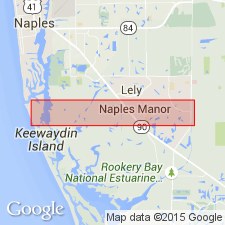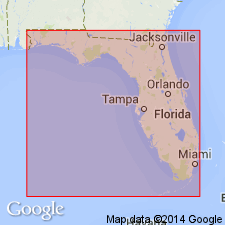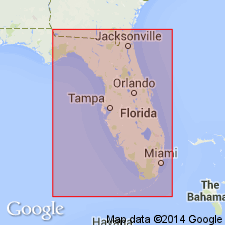
- Usage in publication:
-
- Big Cypress Group
- Modifications:
-
- Named
- Dominant lithology:
-
- Limestone
- Dolomite
- Anhydrite
- AAPG geologic province:
-
- South Florida province
Summary:
Named for Big Cypress Swamp near type section. Formerly called Fredericksburg Group by other workers and the petroleum industry. Type section is Humble No. 1 Collier Corp. well, sec. 27, T50S, R26E, Collier Co., FL , in southern Florida, interval from 9850 to 11,208 ft. Consists of limestone, dolomite, and anhydrite. Includes the Dollar Bay Formation (named in this report), and an underlying unnamed sequence of rocks. Underlies unnamed Washita beds; overlies unnamed Trinity beds. Age is Early Cretaceous (middle Albian, Fredericksburg).
Source: GNU records (USGS DDS-6; Reston GNULEX).

- Usage in publication:
-
- Big Cypress Group*
- Modifications:
-
- Overview
- AAPG geologic province:
-
- South Florida province
Summary:
Shown (undivided) in the subsurface of the eastern Gulf Coastal Plain. Age is Early Cretaceous (middle and late Albian, Fredericksburgian).
Source: GNU records (USGS DDS-6; Reston GNULEX).

- Usage in publication:
-
- Big Cypress Group*
- Modifications:
-
- Overview
- AAPG geologic province:
-
- Florida platform
Summary:
Early Cretaceous Big Cypress Group, including its Marco Junction, Gordon Pass, and Dollar Bay Formations, used following Faulkner and Applegate (1986, Gulf Coast Association of Geological Societies Transactions, v. 36, p. 83-96) and Lloyd (1991, Florida Geological Survey Information Circular 107, p. 1-62).
Source: GNU records (USGS DDS-6; Reston GNULEX).
For more information, please contact Nancy Stamm, Geologic Names Committee Secretary.
Asterisk (*) indicates published by U.S. Geological Survey authors.
"No current usage" (†) implies that a name has been abandoned or has fallen into disuse. Former usage and, if known, replacement name given in parentheses ( ).
Slash (/) indicates name conflicts with nomenclatural guidelines (CSN, 1933; ACSN, 1961, 1970; NACSN, 1983, 2005, 2021). May be explained within brackets ([ ]).

